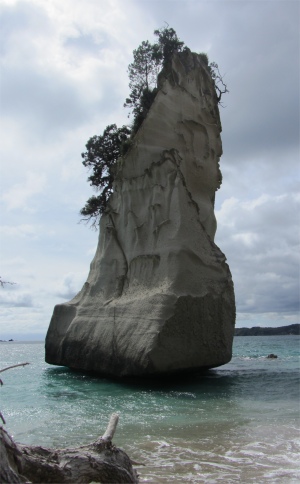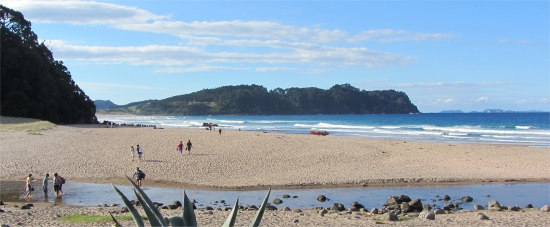
Te Hoho
|
A little way off the beach at Cathedral Cove is a large pinnacle of pumice breccia rock known as "Te Hoho". Over centuries this has been sculpted by wind and water; it now looks like the prow of a large ship steaming into the beach.
I met up with two Kiwi brothers on the beach, who I had bumped into at Gemstone Bay. They came from Auckland, Waiheke Island to be precise. As children they used to camp at Lonely Bay, slightly further up the coast, and always had a fondness for the area. They were both retired now, and spent a lot of time travelling around New Zealand. One of their favourite travel modes was delivering mobile homes from Christchurch back to Auckland. They had to sort out their own insurance, and pay the companies $1 per day, but in return the companies paid for the ferry costs, and allowed them 5 days to deliver the vehicle.
They occupied a large house on Waiheke Island, and their mother still lived there. As a consequence it was always full of folk and family visiting. In order to get some respite from the constant deluge of people, the brothers had waited until the property prices were right, and then bought another property near Whitianga, quite close to Hahei. We put the world to right on immigration laws for our two countries, and discussed at length travel in New Zealand before going our separate ways.

Hot Water Beach - Digging Activity in the Distance
|
By chance, I came across Kevin again, the South African chap I had been talking to the evening before, and we hiked back to Hahei camp together. Since we both had an interest in guitar, he being quite proficient and me being a complete amateur, we discussed the music he likes to play. He had no favourites and tackled all manner of music. He had started off with jazz, since his father had been a jazz musician. Kevin referred to himself as being musically illiterate, he didn't get on with playing other people's music, and preferred to compose his own music and build it up through a series of recordings.
"What do you do with your property when you are away for such a long time?" I asked him. "Three years ago, I could sense that work was drying up. I therefore decided to convert my property into a five-bedroom boarding house, and I live in one of the rooms. The others are let to immigrants on a long term basis, usually 6 month or one year periods. I have a friend who looks after that side of the business while I am away. In a way, running the boarding house fits in quite nicely with the one or two hours work I do on software," he told me. He had ideas up his sleeve for a new software development system, which he will focus on more closely as his other work declined. He seemed to me to be living the life of Riley, and why not, good on him.

Digging Parties
|
Considerable signs of previous volcanism exist on the peninsula. It contains the eroded remnants of the Coromandel Volcanic Zone, which was highly active during the Miocene and Pliocene periods. Volcanic activity has since primarily shifted southeast to the Taupo Volcanic Zone. Geothermal activity is still present on the Peninsula, with hot springs in several places, notably at Hot Water Beach, in the central east coast between Whitianga and Tairua, and it was here where I headed for shortly before low tide.
Lurking at a point below Hot Water Beach, a volcano has developed a huge underground reservoir of superheated water. Over time, this water escapes to the surface, cooling on the way. There are two fissures at Hot Water Beach, issuing water as hot as 64�C (147�F) at a rate as high as 15 litres/minute. This water contains large amounts of salt (NOT salt water), calcium, magnesium, potassium, fluorine, bromine and silica. There are other hot water springs nearby but the location of these two springs on the beach make them unique.
Surprisingly, this is just a stone's throw away from the summer waters of the Pacific Ocean. Lined by a feisty surf beach, with Castle Rock in the foreground, and a long shard of cliffs, Hot Water Beach is book-ended by tufts of pohutukawa trees. In between, white sands hide an underground river of hot water that flows from the Earth's interior to surface in this picturesque location.
I arrived at the beach and joined the orderly queue to hire a shovel in order to excavate my own hot pool. For two hours either side of low tide at this Coromandel beach, a solid sand dig will unearth hot spring water to feed one's very own beachside pool. It wasn't difficult to miss which small areas of the beach exhibited these thermal properties, identified by flocks of people putting their full force behind a sandy excavation at this prime coastal spot. And, as the endeavours reach fever pitch, Hot Water Beach becomes pockmarked with large super-heated soaking holes brimming with relaxed bathers.
I walked around, digging my toes into the sand trying to find the hot spots. There were none as far as I could tell, so I plonked myself in front of one of the existing pools and started to dig to the centre of the earth. A short distance, no more than 2m away, and elderly English couple were saying how it was too hot to handle. Indeed the water where they were sitting was rather warm, and just 15cm below the surface the temperature was unbearable. I extended my dugout in their direction and soon had a hot spa of my own.
The couple came from Manchester, and since they had relatives in this country, they had been here quite often. After a month here they were off to Australia for a month, then stopping off in Hong Kong on their way back. Crumbs, how will they handle rainy Manchester after all that?
As the tide receded, my pool became uncomfortably hot. Other pools were steaming and one was actually boiling. I indulged myself for an hour or so in the hot waters, amazed at how we could all get such a kick out of hot water emanating from a sandy beach. However, boredom soon set in, and I headed back to my wagon, occasionally gazing back at the spectacle resembling a gumdiggers field. With the ebb and flow of the tide, each individually created hot pool is completely washed away, creating a fresh sandy palette ready for the next influx of visitors.

